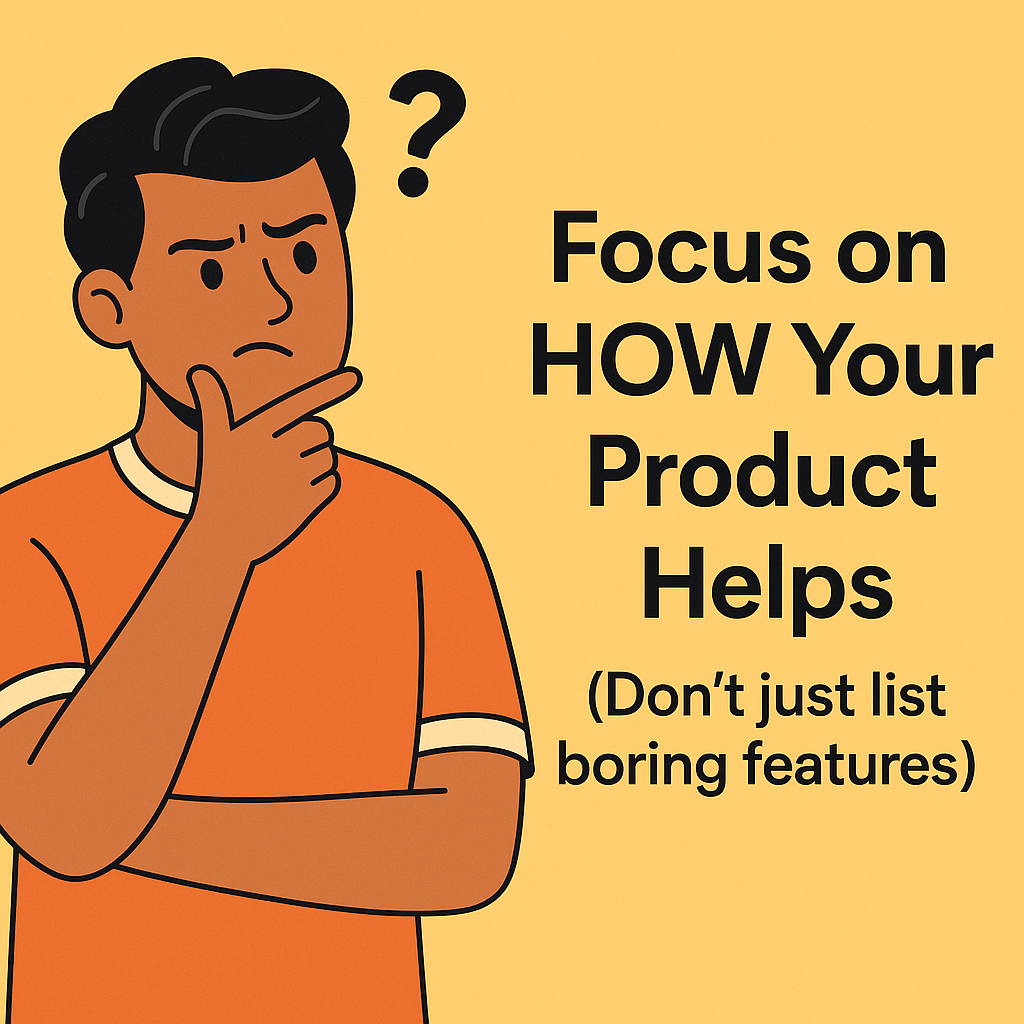
7 Powerful Ways to Write Product Descriptions That Convert (Even for Boring Products)
Let’s be honest about Product Descriptions That Convert — most product descriptions are a straight-up snoozefest.
Table Of Content
“High-quality plastic, Durable, Lightweight, Multipurpose use.”
Cool And?
That’s not going to make anyone buy. Especially not Indian buyers who’ve already been scammed by shady Instagram stores, fake product photos, and COD nightmares.
You want conversions? You better write like someone who sells, not someone writing for an Amazon listing. You pitch like you’re in Sarojini Nagar — fast, clear, convincing, and with no confusion.
Think of it this way:
- You’re not selling a “product.” You’re selling a moment of relief.
- You’re not listing specs. You’re painting a mini-scene in the customer’s mind.
- You’re not convincing logic. You’re nudging emotions.
And here’s the kicker: even boring products can sell like fire. You just need to frame them right.
So whether you’re selling mops, steel lunch boxes, plastic containers, or bathroom organizers — this guide will help you turn “meh” into “must-have.”
Let’s break it down.
1. Don’t Describe the Product — Sell the Outcome
People don’t care about the “product.” They care about the after-effect.
No one buys a mop because it’s made of stainless steel. They buy it to clean fast, avoid back pain, and feel in control of their space.
✅ Translate features into real-world benefits:
- “Made from stainless steel” → “Won’t rust even if you forget it outside for a week. Built to last years.”
- “360° rotating head” → “Reaches tight corners under your bed without bending. Saves time + your spine.”
✅ Always ask yourself: So what? after every feature. That will force you to turn it into a benefit.
Remember, customers don’t read spec sheets. They imagine how it’ll help them. Sell that picture.
2. Lead With a Hook — Not the Material

Your first line is your make-or-break moment. If the sentence is weak, they’re gone. Scroll over. Bounce. Ad budget wasted.
Most product pages open with dry lines like: “Made from high-grade ABS plastic…”
❌ Who cares? Your buyer doesn’t.
✅ Instead, hit them with something real:
Tired of mops that break in 3 weeks? We built this for Indian floors, spills, and busy lives.
Your hook should slap — immediately. It should feel like the customer just thought that exact thing this morning.
Lead with a pain point. Use language that sounds like your buyer — not your supplier.
Examples:
- “Another water bottle leaked in your bag? Not this one.”
- “Still cleaning with that jhadoo that sheds like a cat? Time to level up.”
- “Why do all bathroom shelves look good but hold nothing? This one’s different.”
✅ Tip: Start with emotion, not facts. ✅ Use short, punchy lines — avoid robotic intros.
Your goal? Get them to read line 2. That’s it. Once they’re in, you’ve got a shot at closing the sale.
3. Use Bullet Points — Not Essays
Indian customers scroll like ninjas. If your description looks like a wall of text, it’s game over. No one’s reading your long essay about why this plastic bucket is “perfect for home and office use.”
We’re in the Swiggy–Zomato attention economy. You’ve got 2 seconds — max — to convince.
✅ Break it down like this:
- 🚚 Delivers in 4–6 days across India (fast dispatch = trust)
- 🧼 Works on tiles, wood, marble — doesn’t scratch floors
- 🔧 Sets up in 60 seconds — no tools, no headache
- 🎁 Comes with 2 extra mop heads — more life, less drama
- 💰 COD available + easy returns (for the overthinkers)
Each bullet should be one powerful punch of value. One line = one reason to buy.
Also:
- Start with your strongest USP — don’t bury it at the bottom.
- Don’t list features that don’t directly benefit the buyer. Keep it tight.
✅ Pro tip: Break monotony with icons or emojis — it adds visual rhythm. But don’t overdo it like a WhatsApp forward.
If your bullets feel like a checklist your buyer would make in their head — you nailed it.
Make it skimmable, snappy, and sales-focused. That’s how you win the scroll war.
4. Add Usage Context (Make Them Imagine Using It)

Paint a mini scene in their head — something real, something desi, something they relate to without overthinking.
✅ “Perfect for moms scrubbing masala spills after lunch — without bending for 20 minutes.” ✅ “Great for bachelors who just want the floor clean without calling the maid thrice.” ✅ “Fits easily in your hostel bucket. Doesn’t eat up space or your patience.”
These aren’t fancy lifestyle lines. These are real-world moments. Everyday headaches that your product helps solve.
Want to sell more? Start writing like you know what your buyer’s morning looks like.
✅ “For the dad who wants to clean up before guests arrive.” ✅ “For the college student who’s sick of roommates leaving a mess.” ✅ “For the new mom juggling a baby in one hand and a dirty floor in the other.”
Even the most boring item becomes personal when you plug it into someone’s life. Add emotion to function. Show where the product fits into their story.
Because the truth is: people don’t buy products — they buy better versions of their daily routines.
5. Add Urgency + Trust Elements

Don’t just describe, Persuade, You’ve got their attention — now push them to act.
✅ Add:
- “Fast delivery from our Indian warehouse.”
- “COD available on all orders.”
- “Only 47 left in stock.”
- “Rated 4.8★ by 3,100+ customers.”
Fear of missing out + social proof = conversions.
You don’t need to lie. Just add real scarcity or a genuine reason to act now.
✅ Even better: Use phrases like “selling fast”, “last batch shipping today” , or “only 3 per order allowed” .
6. Translate Specs into Simple Language

Most dropshippers just copy-paste the supplier’s technical details and call it a day.
But let’s be real — your buyer isn’t some tech reviewer comparing voltage and IP ratings. They’re just asking: “Will this work for me?”
Nobody wants to decode: “5V, 1.5A Type-C USB, 800mAh.”
✅ Instead, say: “Works with your regular Android cable. Charges in under an hour, lasts 2–3 days easy.”
Make it human. Make it real.
Here’s how to break it down:
- “IP67 water-resistant” → “Survives splashes, even if your kid drops water on it.”
- “300 lumens LED” → “Lights up your whole bedroom during load shedding.”
- “ABS material” → “Feels solid in your hand, doesn’t crack if it slips.”
The golden rule? Speak like your buyer thinks. If your customer can’t picture it in their life, they won’t buy it — no matter how great the spec sounds.
Specs aren’t useless — they’re just not enough on their own. Translate them into how they’ll feel in real usage.
✅ Extra tip: Add comparison lines.
- “Twice as powerful as your average power bank.”
- “As compact as your TV remote — fits in pocket, bag, or even your bike’s side box.”
You’re not just translating — you’re decoding. You’re making tech sound like everyday life.
And when that happens? Buyers don’t hesitate. They click ‘Buy Now’ — because it sounds like it was made for them.
Final Words on Product Descriptions That Convert
Even a boring product can sell like crazy — if you show buyers how it helps them.
✅ Make it relatable
✅ Show real-life use
✅ Skip fluff, highlight outcomes
✅ Add urgency + trust
✅ Speak their language, not engineer-speak
You’re not writing for a catalogue. You’re writing to convert.
👉 Follow Dropshipping.blog for more brutally practical tips that help you sell smarter in the Indian market.






